1999 DODGE RAM engine
[x] Cancel search: enginePage 643 of 1691
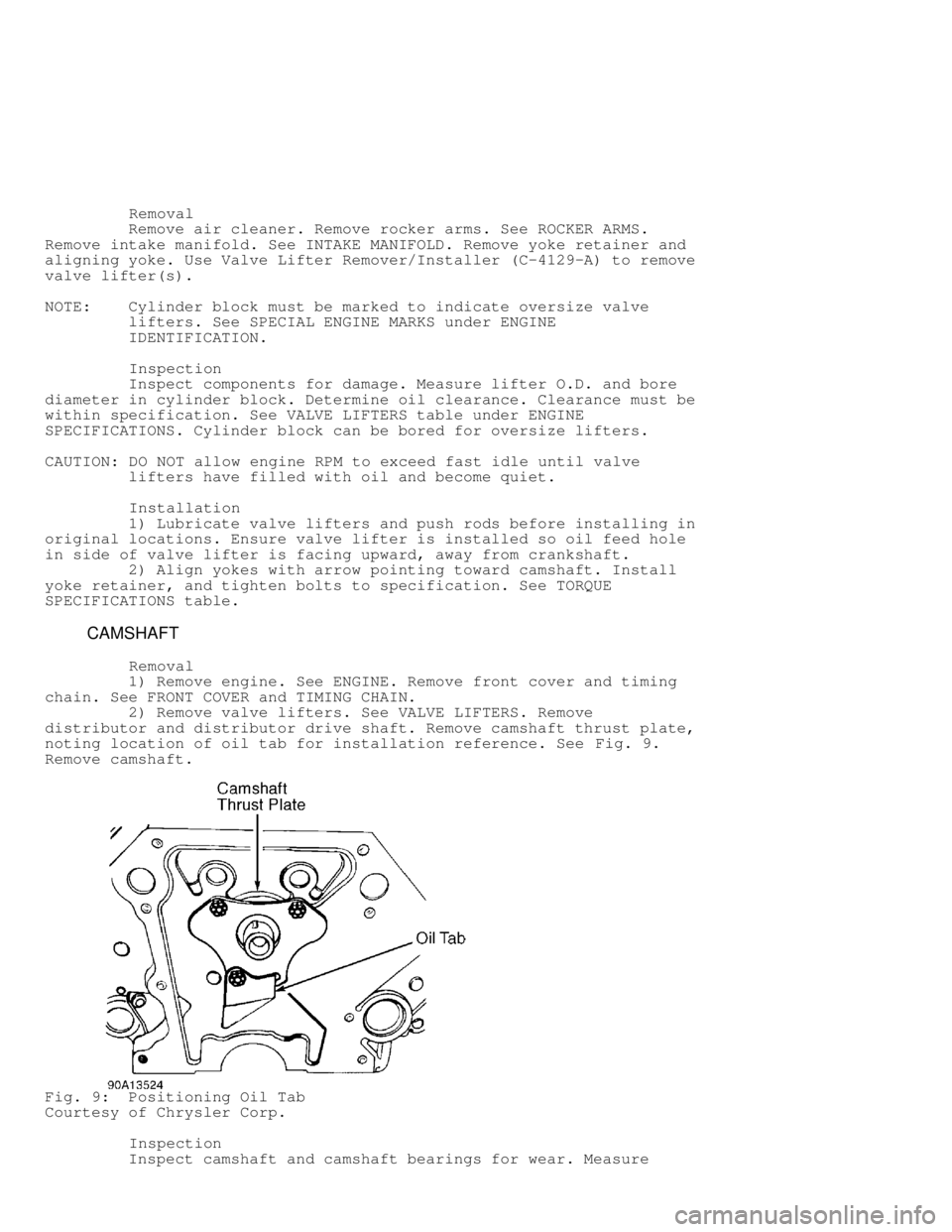
Removal
Remove air cleaner. Remove rocker arms. See ROCKER ARMS.
Remove intake manifold. See INTAKE MANIFOLD. Remove yoke retainer and
aligning yoke. Use Valve Lifter Remover/Installer (C-4129-A) to remove\
valve lifter(s).
NOTE: Cylinder block must be marked to indicate oversize valve
lifters. See SPECIAL ENGINE MARKS under ENGINE
IDENTIFICATION.
Inspection
Inspect components for damage. Measure lifter O.D. and bore
diameter in cylinder block. Determine oil clearance. Clearance must be
within specification. See VALVE LIFTERS table under ENGINE
SPECIFICATIONS. Cylinder block can be bored for oversize lifters.
CAUTION: DO NOT allow engine RPM to exceed fast idle until valve
lifters have filled with oil and become quiet.
Installation
1) Lubricate valve lifters and push rods before installing in
original locations. Ensure valve lifter is installed so oil feed hole
in side of valve lifter is facing upward, away from crankshaft.
2) Align yokes with arrow pointing toward camshaft. Install
yoke retainer, and tighten bolts to specification. See TORQUE
SPECIFICATIONS table.
CAMSHAFT
Removal
1) Remove engine. See ENGINE. Remove front cover and timing
chain. See FRONT COVER and TIMING CHAIN.
2) Remove valve lifters. See VALVE LIFTERS. Remove
distributor and distributor drive shaft. Remove camshaft thrust plate,
noting location of oil tab for installation reference. See Fig. 9.
Remove camshaft.
Fig. 9: Positioning Oil Tab
Courtesy of Chrysler Corp.
Inspection
Inspect camshaft and camshaft bearings for wear. Measure
Page 644 of 1691

camshaft journal diameter and camshaft bearing I.D. Replace camshaft
or camshaft bearings if not within specification. See CAMSHAFT table
under ENGINE SPECIFICATIONS.
CAUTION: If camshaft is replaced, valve lifters must also be replaced.
Whenever new camshaft or valve lifters are installed,
manufacturer recommends addition of one pint of Chrysler
crankcase conditioner to engine oil for at least 500 miles to
aid break-in.
Installation
1) Ensure cup plugs are installed in oil passages behind
thrust plate. Lubricate camshaft and bearings, and install within 2"
(50.8 mm) of final installation location.
2) Install Camshaft Installer (C-3509), with long area behin\
d
distributor drive gear. See Fig. 10. This prevents camshaft from
contacting plug located in rear of cylinder block. Install distributor
lock bolt to retain camshaft installer.
3) Install camshaft thrust plate and oil tab. Ensure tang
engages with lower right hole of camshaft thrust plate. Tighten
camshaft thrust plate bolts to specification. See TORQUE
SPECIFICATIONS table. Top edge of oil tab should be flat against
camshaft thrust plate for timing chain lubrication. See Fig. 9.
4) To install remaining components, reverse removal
procedure. Check camshaft end play. If end play exceeds specification,
replace thrust plate. See CAMSHAFT table under ENGINE SPECIFICATIONS.
Ensure components are installed in original location.
CAUTION: DO NOT allow engine RPM to exceed fast idle until valve
lifters have filled with oil and become quiet.
Fig. 10: Installing Camshaft
Courtesy of Chrysler Corp.
CAMSHAFT BEARINGS
Page 645 of 1691
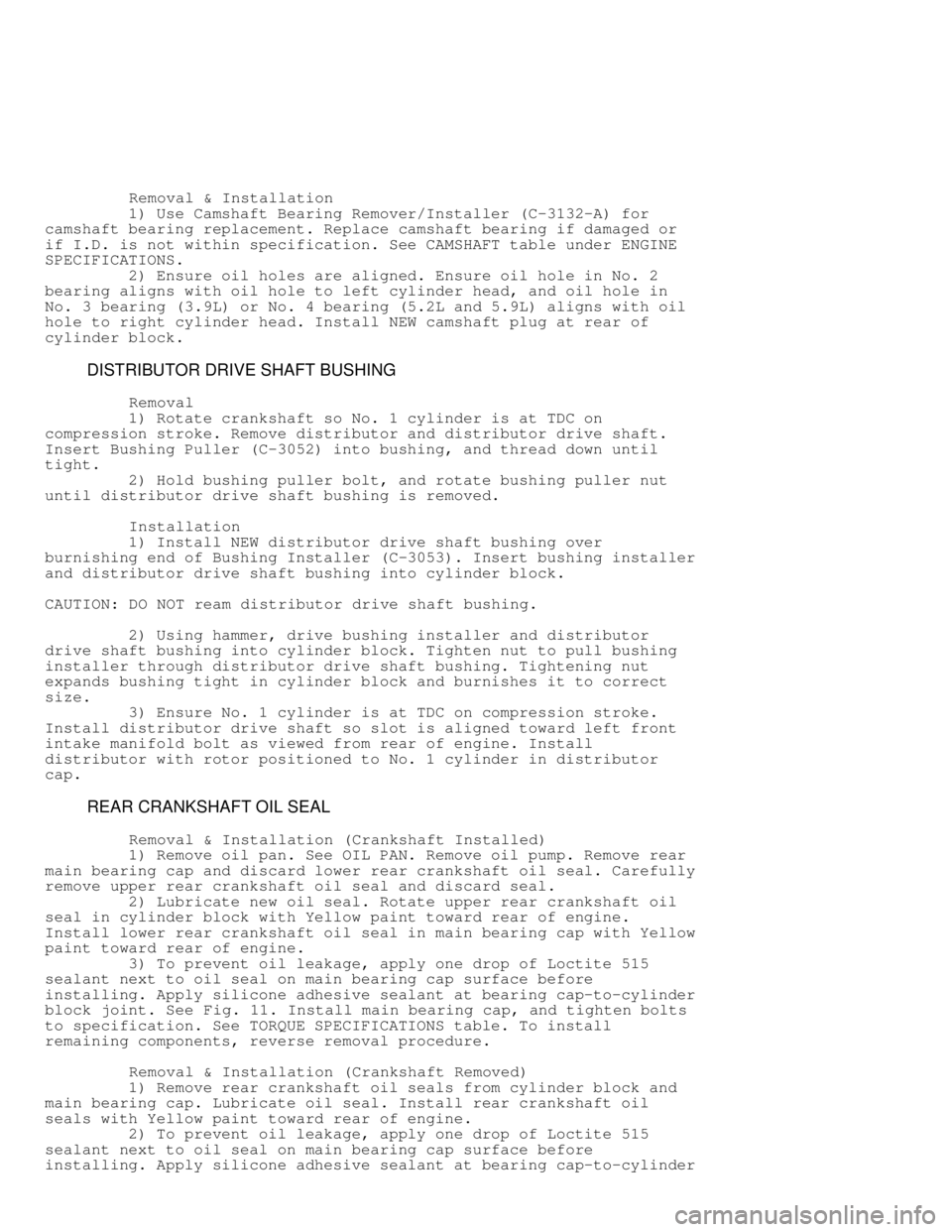
Removal & Installation
1) Use Camshaft Bearing Remover/Installer (C-3132-A) for
camshaft bearing replacement. Replace camshaft bearing if damaged or
if I.D. is not within specification. See CAMSHAFT table under ENGINE
SPECIFICATIONS.
2) Ensure oil holes are aligned. Ensure oil hole in No. 2
bearing aligns with oil hole to left cylinder head, and oil hole in
No. 3 bearing (3.9L) or No. 4 bearing (5.2L and 5.9L) aligns with oi\
l
hole to right cylinder head. Install NEW camshaft plug at rear of
cylinder block.
DISTRIBUTOR DRIVE SHAFT BUSHING
Removal
1) Rotate crankshaft so No. 1 cylinder is at TDC on
compression stroke. Remove distributor and distributor drive shaft.
Insert Bushing Puller (C-3052) into bushing, and thread down until
tight.
2) Hold bushing puller bolt, and rotate bushing puller nut
until distributor drive shaft bushing is removed.
Installation
1) Install NEW distributor drive shaft bushing over
burnishing end of Bushing Installer (C-3053). Insert bushing installer\
and distributor drive shaft bushing into cylinder block.
CAUTION: DO NOT ream distributor drive shaft bushing.
2) Using hammer, drive bushing installer and distributor
drive shaft bushing into cylinder block. Tighten nut to pull bushing
installer through distributor drive shaft bushing. Tightening nut
expands bushing tight in cylinder block and burnishes it to correct
size.
3) Ensure No. 1 cylinder is at TDC on compression stroke.
Install distributor drive shaft so slot is aligned toward left front
intake manifold bolt as viewed from rear of engine. Install
distributor with rotor positioned to No. 1 cylinder in distributor
cap.
REAR CRANKSHAFT OIL SEAL
Removal & Installation (Crankshaft Installed)
1) Remove oil pan. See OIL PAN. Remove oil pump. Remove rear
main bearing cap and discard lower rear crankshaft oil seal. Carefully
remove upper rear crankshaft oil seal and discard seal.
2) Lubricate new oil seal. Rotate upper rear crankshaft oil
seal in cylinder block with Yellow paint toward rear of engine.
Install lower rear crankshaft oil seal in main bearing cap with Yellow
paint toward rear of engine.
3) To prevent oil leakage, apply one drop of Loctite 515
sealant next to oil seal on main bearing cap surface before
installing. Apply silicone adhesive sealant at bearing cap-to-cylinder
block joint. See Fig. 11. Install main bearing cap, and tighten bolts
to specification. See TORQUE SPECIFICATIONS table. To install
remaining components, reverse removal procedure.
Removal & Installation (Crankshaft Removed)
1) Remove rear crankshaft oil seals from cylinder block and
main bearing cap. Lubricate oil seal. Install rear crankshaft oil
seals with Yellow paint toward rear of engine.
2) To prevent oil leakage, apply one drop of Loctite 515
sealant next to oil seal on main bearing cap surface before
installing. Apply silicone adhesive sealant at bearing cap-to-cylinder
Page 647 of 1691
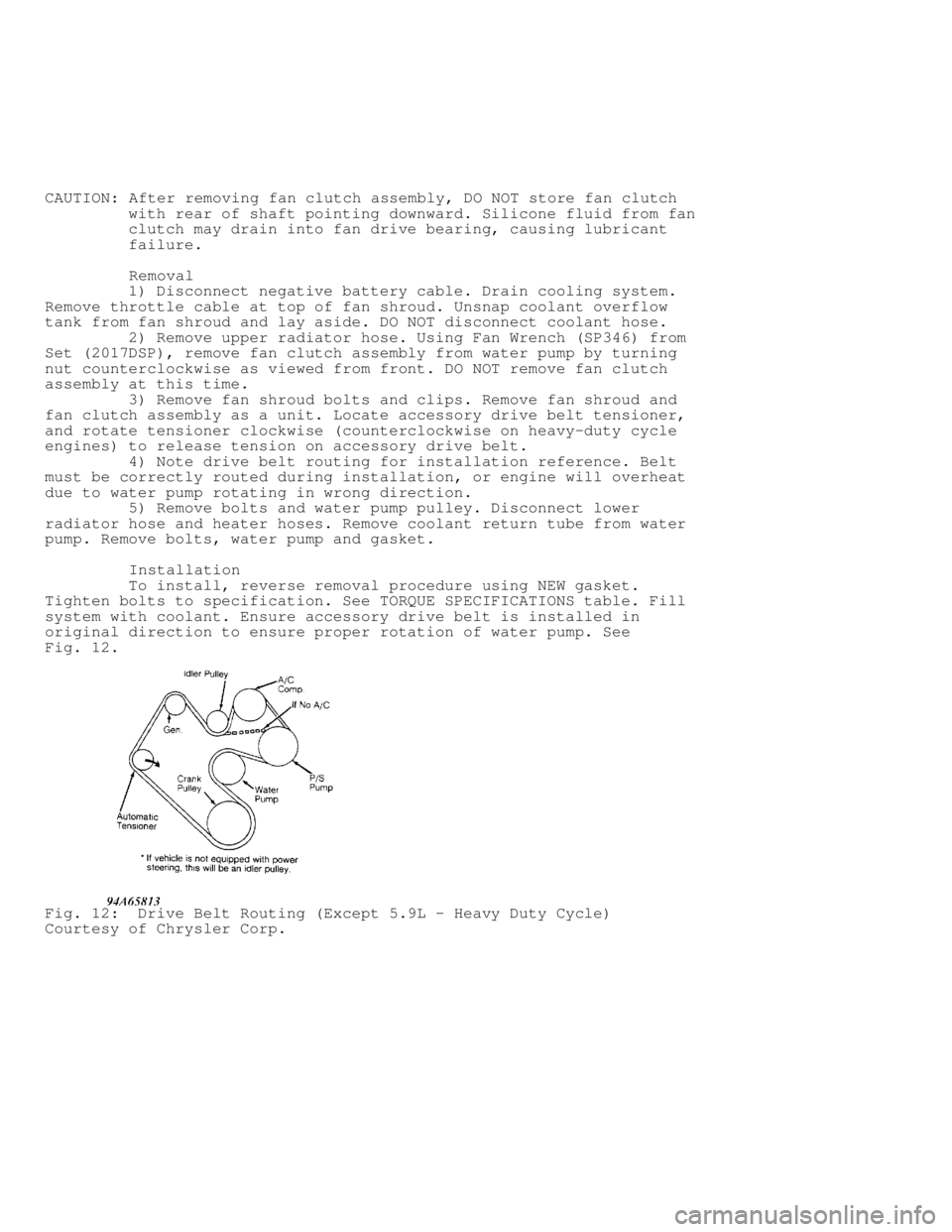
CAUTION: After removing fan clutch assembly, DO NOT store fan clutch
with rear of shaft pointing downward. Silicone fluid from fan
clutch may drain into fan drive bearing, causing lubricant
failure.
Removal
1) Disconnect negative battery cable. Drain cooling system.
Remove throttle cable at top of fan shroud. Unsnap coolant overflow
tank from fan shroud and lay aside. DO NOT disconnect coolant hose.
2) Remove upper radiator hose. Using Fan Wrench (SP346) from\
Set (2017DSP), remove fan clutch assembly from water pump by turning
nut counterclockwise as viewed from front. DO NOT remove fan clutch
assembly at this time.
3) Remove fan shroud bolts and clips. Remove fan shroud and
fan clutch assembly as a unit. Locate accessory drive belt tensioner,
and rotate tensioner clockwise (counterclockwise on heavy-duty cycle
engines) to release tension on accessory drive belt.
4) Note drive belt routing for installation reference. Belt
must be correctly routed during installation, or engine will overheat
due to water pump rotating in wrong direction.
5) Remove bolts and water pump pulley. Disconnect lower
radiator hose and heater hoses. Remove coolant return tube from water
pump. Remove bolts, water pump and gasket.
Installation
To install, reverse removal procedure using NEW gasket.
Tighten bolts to specification. See TORQUE SPECIFICATIONS table. Fill
system with coolant. Ensure accessory drive belt is installed in
original direction to ensure proper rotation of water pump. See
Fig. 12 .
Fig. 12: Drive Belt Routing (Except 5.9L - Heavy Duty Cycle)
Courtesy of Chrysler Corp.
Page 648 of 1691
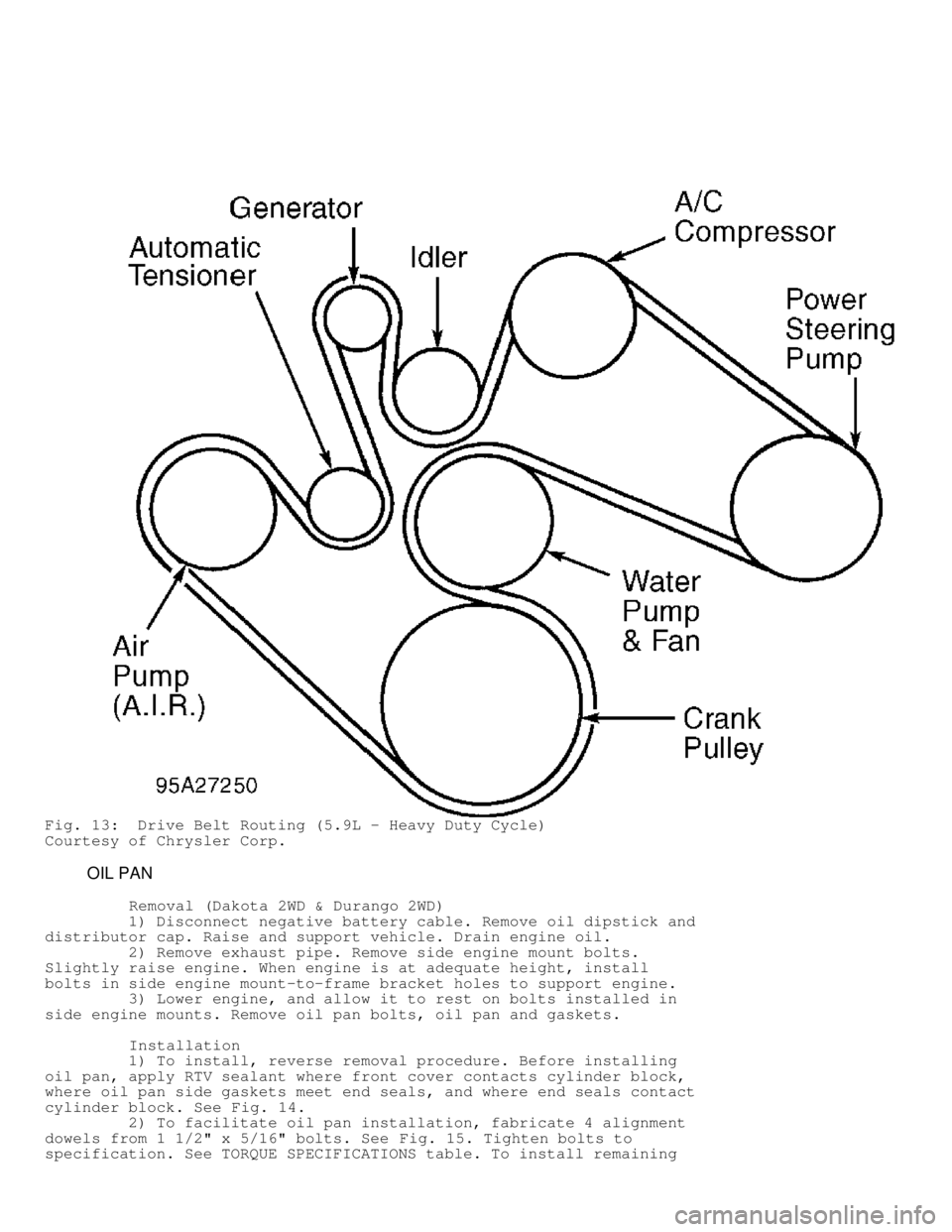
Fig. 13: Drive Belt Routing (5.9L - Heavy Duty Cycle)
Courtesy of Chrysler Corp.
OIL PAN
Removal (Dakota 2WD & Durango 2WD)
1) Disconnect negative battery cable. Remove oil dipstick and
distributor cap. Raise and support vehicle. Drain engine oil.
2) Remove exhaust pipe. Remove side engine mount bolts.
Slightly raise engine. When engine is at adequate height, install
bolts in side engine mount-to-frame bracket holes to support engine.
3) Lower engine, and allow it to rest on bolts installed in
side engine mounts. Remove oil pan bolts, oil pan and gaskets.
Installation
1) To install, reverse removal procedure. Before installing
oil pan, apply RTV sealant where front cover contacts cylinder block,
where oil pan side gaskets meet end seals, and where end seals contact
cylinder block. See Fig. 14.
2) To facilitate oil pan installation, fabricate 4 alignment
dowels from 1 1/2" x 5/16" bolts. See Fig. 15. Tighten bolts to
specification. See TORQUE SPECIFICATIONS table. To install remaining
Page 649 of 1691
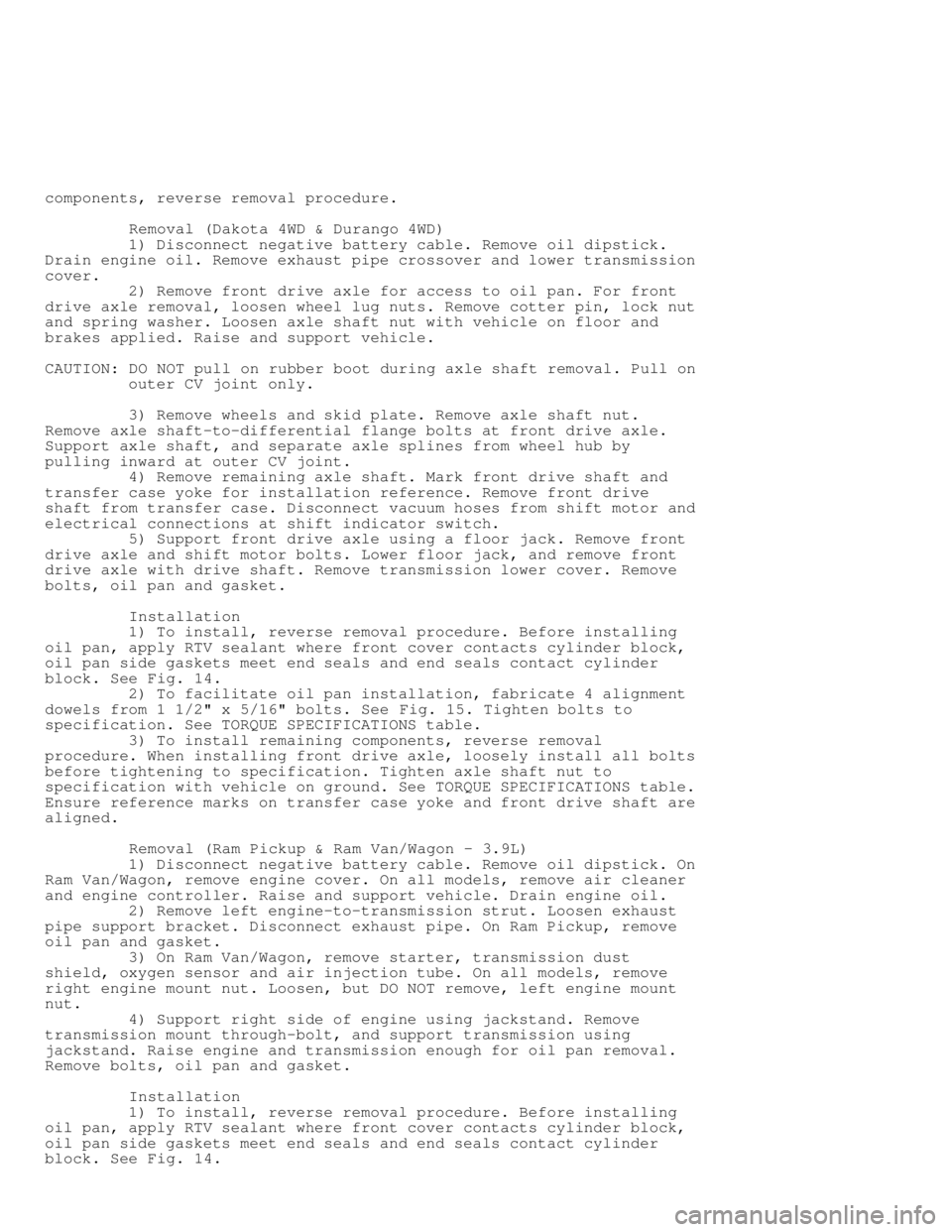
components, reverse removal procedure.
Removal (Dakota 4WD & Durango 4WD)
1) Disconnect negative battery cable. Remove oil dipstick.
Drain engine oil. Remove exhaust pipe crossover and lower transmission
cover.
2) Remove front drive axle for access to oil pan. For front
drive axle removal, loosen wheel lug nuts. Remove cotter pin, lock nut
and spring washer. Loosen axle shaft nut with vehicle on floor and
brakes applied. Raise and support vehicle.
CAUTION: DO NOT pull on rubber boot during axle shaft removal. Pull on
outer CV joint only.
3) Remove wheels and skid plate. Remove axle shaft nut.
Remove axle shaft-to-differential flange bolts at front drive axle.
Support axle shaft, and separate axle splines from wheel hub by
pulling inward at outer CV joint.
4) Remove remaining axle shaft. Mark front drive shaft and
transfer case yoke for installation reference. Remove front drive
shaft from transfer case. Disconnect vacuum hoses from shift motor and
electrical connections at shift indicator switch.
5) Support front drive axle using a floor jack. Remove front
drive axle and shift motor bolts. Lower floor jack, and remove front
drive axle with drive shaft. Remove transmission lower cover. Remove
bolts, oil pan and gasket.
Installation
1) To install, reverse removal procedure. Before installing
oil pan, apply RTV sealant where front cover contacts cylinder block,
oil pan side gaskets meet end seals and end seals contact cylinder
block. See Fig. 14.
2) To facilitate oil pan installation, fabricate 4 alignment
dowels from 1 1/2" x 5/16" bolts. See Fig. 15. Tighten bolts to
specification. See TORQUE SPECIFICATIONS table.
3) To install remaining components, reverse removal
procedure. When installing front drive axle, loosely install all bolts
before tightening to specification. Tighten axle shaft nut to
specification with vehicle on ground. See TORQUE SPECIFICATIONS table.
Ensure reference marks on transfer case yoke and front drive shaft are
aligned.
Removal (Ram Pickup & Ram Van/Wagon - 3.9L)
1) Disconnect negative battery cable. Remove oil dipstick. On
Ram Van/Wagon, remove engine cover. On all models, remove air cleaner
and engine controller. Raise and support vehicle. Drain engine oil.
2) Remove left engine-to-transmission strut. Loosen exhaust
pipe support bracket. Disconnect exhaust pipe. On Ram Pickup, remove
oil pan and gasket.
3) On Ram Van/Wagon, remove starter, transmission dust
shield, oxygen sensor and air injection tube. On all models, remove
right engine mount nut. Loosen, but DO NOT remove, left engine mount
nut.
4) Support right side of engine using jackstand. Remove
transmission mount through-bolt, and support transmission using
jackstand. Raise engine and transmission enough for oil pan removal.
Remove bolts, oil pan and gasket.
Installation
1) To install, reverse removal procedure. Before installing
oil pan, apply RTV sealant where front cover contacts cylinder block,
oil pan side gaskets meet end seals and end seals contact cylinder
block. See Fig. 14.
Page 650 of 1691
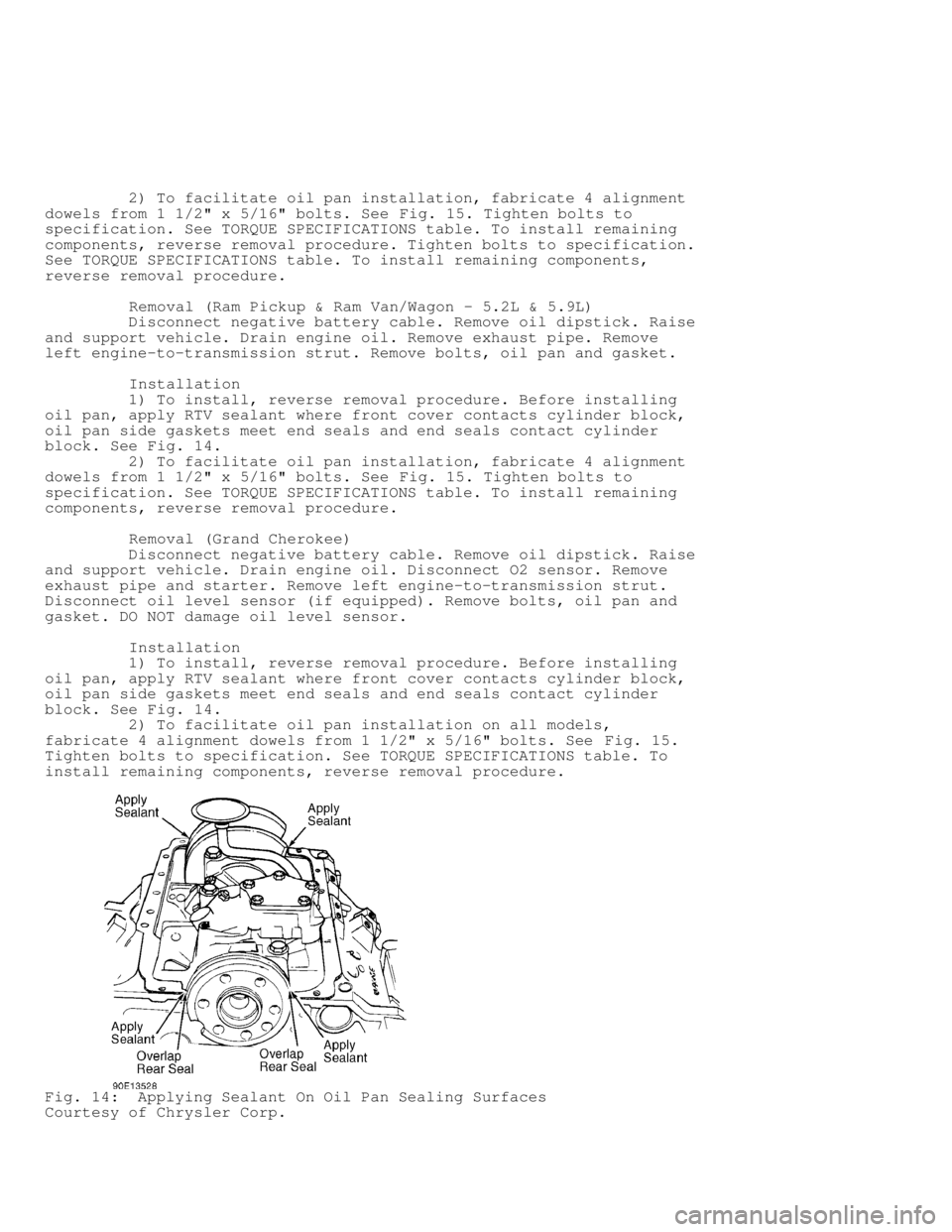
2) To facilitate oil pan installation, fabricate 4 alignment
dowels from 1 1/2" x 5/16" bolts. See Fig. 15. Tighten bolts to
specification. See TORQUE SPECIFICATIONS table. To install remaining
components, reverse removal procedure. Tighten bolts to specification.
See TORQUE SPECIFICATIONS table. To install remaining components,
reverse removal procedure.
Removal (Ram Pickup & Ram Van/Wagon - 5.2L & 5.9L)
Disconnect negative battery cable. Remove oil dipstick. Raise
and support vehicle. Drain engine oil. Remove exhaust pipe. Remove
left engine-to-transmission strut. Remove bolts, oil pan and gasket.
Installation
1) To install, reverse removal procedure. Before installing
oil pan, apply RTV sealant where front cover contacts cylinder block,
oil pan side gaskets meet end seals and end seals contact cylinder
block. See Fig. 14.
2) To facilitate oil pan installation, fabricate 4 alignment
dowels from 1 1/2" x 5/16" bolts. See Fig. 15. Tighten bolts to
specification. See TORQUE SPECIFICATIONS table. To install remaining
components, reverse removal procedure.
Removal (Grand Cherokee)
Disconnect negative battery cable. Remove oil dipstick. Raise
and support vehicle. Drain engine oil. Disconnect O2 sensor. Remove
exhaust pipe and starter. Remove left engine-to-transmission strut.
Disconnect oil level sensor (if equipped). Remove bolts, oil pan and
gasket. DO NOT damage oil level sensor.
Installation
1) To install, reverse removal procedure. Before installing
oil pan, apply RTV sealant where front cover contacts cylinder block,
oil pan side gaskets meet end seals and end seals contact cylinder
block. See Fig. 14.
2) To facilitate oil pan installation on all models,
fabricate 4 alignment dowels from 1 1/2" x 5/16" bolts. See Fig. 15.
Tighten bolts to specification. See TORQUE SPECIFICATIONS table. To
install remaining components, reverse removal procedure.
Fig. 14: Applying Sealant On Oil Pan Sealing Surfaces
Courtesy of Chrysler Corp.
Page 652 of 1691

CYLINDER HEAD
Cylinder Head
Check cylinder head warpage. Repair or replace cylinder head
if warpage exceeds specification. See CYLINDER HEAD table under ENGINE
SPECIFICATIONS.
Valve Springs
1) Check valve spring free length, out-of-square and
pressure. Replace valve spring if not within specification. See VALVES
& VALVE SPRINGS table under ENGINE SPECIFICATIONS.
2) Measure valve spring installed height from bottom of
spring seat (cylinder head surface) to bottom of spring retainer. If
spacers are installed, measure from top of spacer.
3) If height exceeds 1.687" (42.86 mm), install a .066" (1.\
58
mm) thick spacer in cylinder head counterbore to obtain correct
installed spring height. See VALVES & VALVE SPRINGS table.
Valve Stem Oil Seals
Cup-type oil seals are used on all valves. Ensure oversize
valve stem oil seals are used when oversize valves are installed. When
installing valves, DO NOT overcompress valve springs, or damage to
valve stem oil seal may result.
NOTE: DO NOT ream valve guides from standard to maximum oversize in
one step. Ream valve guides to oversize in gradual steps so
guides are reamed true in relation to valve seat. After
reaming valve guides, valve seat runout must be checked.
Valve Guides
Check valve stem oil clearance. Ensure valve stem diameter is
within specification. Valve guide must be reamed for valve with
oversize valve stem if oil clearance exceeds specification. See
CYLINDER HEAD table under ENGINE SPECIFICATIONS. Valves are available
with stems of .015" (.38 mm) and .030" (.76 mm) oversize.
Valve Seat
Check valve seat width and runout. Grind valve seat if not
within specification. See CYLINDER HEAD table under ENGINE
SPECIFICATIONS.
Valves
Ensure valve margin, head diameter and stem diameter are
within specification. See VALVES & VALVE SPRINGS table under ENGINE
SPECIFICATIONS. Valves are available with stems of .015" (.38 mm) and
.030" (.76 mm) oversize.
Valve Seat Correction Angles
Use a 15-degree stone to lower valve seat, and a 60-degree
stone to raise valve seat.
VALVE TRAIN
Rocker Arms & Pivots
Remove rocker arms and pivots. Inspect for wear. Replace as
necessary.
NOTE: Cylinder block must be marked to indicate oversize valve
lifters. See SPECIAL ENGINE MARKS.
Valve Lifters
Measure valve lifter diameter and bore diameter in cylinder